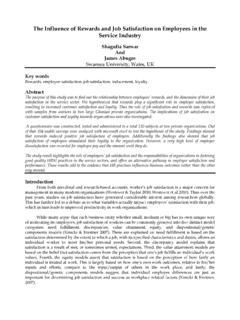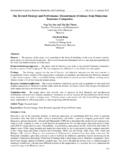Transcription of Total Rewards in Action:Developing a Total R
1 32 August 2005 Benefits & Compensation DigestWhat Are Total Rewards ?The concept of Total Rewards em-braces everything employees valuein their employment holistic concept is driven by thechanging perspective of employees andwhat they concept integrates four major cat-egories of Rewards :1. Compensation2. Benefits3. Development4. Work pay, in-centives (both short term and long term,including equity) and monetary recogni-tion programs. Benefitsinclude health andwelfare, retirement and capital accumula-tion programs, as well as a wide variety ofspecialty programs such as child-care re-sources, fitness centers, concierge servicesand everything in between. Developmentrelates to programs that promote learningTotal Rewards in Action: Developing a Total RToday, the term Total Rewards is common, but that wasn t always the case.
2 In fact, asfew as ten years ago, many people would not have recognized the terminology. Thechallenge of attracting and retaining talent amid changing demographics and intensecompetition has led employers to finally recognize what employees have been saying forawhile It s not about pay only. It s the Total offering that attracts, retains and motivatesworkers today. This discussion focuses on developing a Total Rewards strategy which,when linked to an overall business strategy, can help your organization achieve its Rewards in Action:Developing a Total Rewards Strategyby Stacey L. Kaplan 2005 International Foundation of Employee Benefit Plansand skill development, career enhance-ment and personal growth. Work Envi-ronmentencompasses both tangible andintangible offerings that promote work/life balance and a positive work experi-ence, such as flexible work arrangements,recognition and innovative job table accompanying this article pres-ents a sample, nonexhaustive list of thecomposition of the four resources professionals oftenrefer to Rewards as being either transac-tional or relational.
3 Rewards in the com-pensation and benefits categories areconsidered transactional Rewards in thatthey re typically financial in nature andinvolve specific programs. Compensationand benefits offerings must be at least ata baseline level of competitiveness to at-tract and retain employees. However,competitors easily copy these types of re-wards. Thus employers find it difficult todifferentiate themselves by their compen-sation and benefits programs in the Development andWork Environment arenas are consideredrelational Rewards and are associatedwith the emotional aspects of an employ-ment relationship. Employers often cus-tomize these types of Rewards to em-ployee-specific needs to differentiatethemselves from their competitors, thusenhancing attraction and retention. Rela-tional Rewards serve as retention motiva-tors, strengthening individual commit-ment and binding employees to Is a Total Rewards Strategy?
4 A Total Rewards strategyis a statementof an organization s human resourcesphilosophy as it relates to Rewards . A totalrewards strategy integrates the four cate-gories of Rewards discussed above Com-pensation, Benefits, Development andWork Environment into a road map forattracting, retaining and motivating theworkforce. In essence, it is a subset of anorganization s people strategy. Whenaligned with the business strategy, a totalrewards strategy facilitates the accom-plishment of the business goals throughreinforcing the behaviors needed to drivethe organization sound Total Rewards strategy definesthe objectives of the Rewards programs,the elements of these programs and howthey interrelate to fulfill these objectives. Itdescribes the philosophy behind the pro-grams, providing the foundation for futureplan design.
5 In developing new programsor refining existing ones, the proposed de-sign should be tested against the Total re-wards strategy to ensure it is in sync and toprevent philosophy and/or design incon-gruities. For example, a Total Rewards strat-egy that emphasizes teamwork as one ofits core values will be out of alignmentwith programs that exclusively reward in-dividual achievements. These disparitiesdetract from reinforcing the behaviorsneeded to execute the business organizations articulate a com-pensation philosophy in writing but fallshort in incorporating other types of re-wards into their strategy. This process ischanging as more organizations adopt aholistic approach to Rewards . Interna-tional companies often extend their totalrewards strategy to their global businessentities to promote consistency and in-ternal equity.
6 Specific country offeringsmay differ, but the underlying philosophyof providing compensation, benefits andother programs to employees at a givencompetitive level, for example, may re-main constant, subject to legal gover-nance constraints. More organizationsare recognizing the power of integratingall Rewards programs under a Total re-wards Develop a Total Rewards Strategy?A Total Rewards strategy offers a num-ber of attractive advantages to an organi-zation. Here are just a few reasons whythis approach resonates with employerstoday:Congruency. A Total Rewards strategyprovides an integrated, comprehensiveview of all Rewards to promote congruencyand effectiveness of plan design and deliv-ery, in alignment with the organization sbusiness strategy and people strategy. Theintent is that all Rewards , both direct andindirect, complement the organizationalgoals and map for HR Total Rewards strategy serves as areference guide to human resourcesprofessionals who are designing newprograms or updating existing August 2005 Benefits & Compensation Digest33 Article BriefsShow Them the MoneyMany employees only see how muchthe company values them in terms oftheir paycheck.
7 A Total Rewards state-ment can show employees their valueto the company by pointing out all thenonwage benefits the employer is pro-viding. Total Rewards includes not justmoney, time off and stock options, buthealth plans, retirement programs andless-quantifiable elements such as flex-ible work arrangements and careertraining. Personalized statements havea greater impact than a general an-nouncement or mass Vanderwerff and Sylvia HR Reporter,April 11, 2005, p. 7.#0145845 For more article briefs, see have an information specialist providecustomized information for you, call (262)786-6710, ext. and SeminarsCertificate SeriesCertificate in Benefits and Compensation Management,September 23-24,New Orleans, LouisianaVisit ; or call(888) 334-3327, option Reward Systems for theChanging Workplace, Second B.
8 Wilson. (McGraw-Hill). 379 pages. Item #8394. $ For book details, see order, call (888) 334-3327, option ADDITIONALR esourcesContinued on next page34 August 2005 Benefits & Compensation DigestThis road map keeps HR practitionersgrounded as they help senior manage-ment execute the company s edge for Rewards strategy provides a compet-itive advantage for attracting talent. Anemployment package structured to ad-dress employee needs bodes well for em-ployers wishing to differentiate them-selves in an environment competing forthe best of-ferings focused on what employeesvalue, enhance employee commitmentand reduce turnover. They reinforce theemotional bond between employer andemployees. Additionally, strategic re-wards, especially when tied to perform-ance, can revitalize a disengaged work-force.
9 In cases of warm chair attrition,where employees have tuned out as ifthey had already left the company, apa-thy can transform into energy with theright labor a Total Rewards strategy may allow an employer to moderate its labor costs bytrading off various components of theemployment package. For example, anemployer may emphasize flexible workarrangements and work/life balance,which tend to cost less, rather than aricher benefit company organization embraces a perfor-mance culture, a Total Rewards strategycan reinforce the desired behaviors thatcontribute to organizational success. Atotal Rewards strategy that addressesemployee needs enhances productivity,since satisfied employees tend to bemore productive. Additionally, there is adirect correlation between employeesatisfaction and customer satisfaction,which should enhance company Components of a Total Rewards StrategyWhen formulating a Total rewardsstrategy, decisions must be made regard-ing the overall objectives of the rewardsprograms, competitiveness, types andmix of Rewards , impact of performance,and communication.
10 These decisions areinfluenced by many factors, both internaland external. From an internal perspec-tive, an organization s mission, vision, val-ues and culture drive reward design. Alsoits financial health and life cycle positionaffect the dollars available to develop andmaintain programs. For example, a start-up technology company with limitedcash flow may emphasize variable pay,longer term Rewards and a progressivelearning environment over base salary. Amature financial institution may favor aricher benefits package plus a less lever-aged variable pay demographics play a signif-icant role in driving the type of rewardsoffered. A young workforce s needs differdramatically from those of a more ma-ture workforce. Today s generation of em-ployees highly value relational rewardslike career development, learning newskills and time off.






